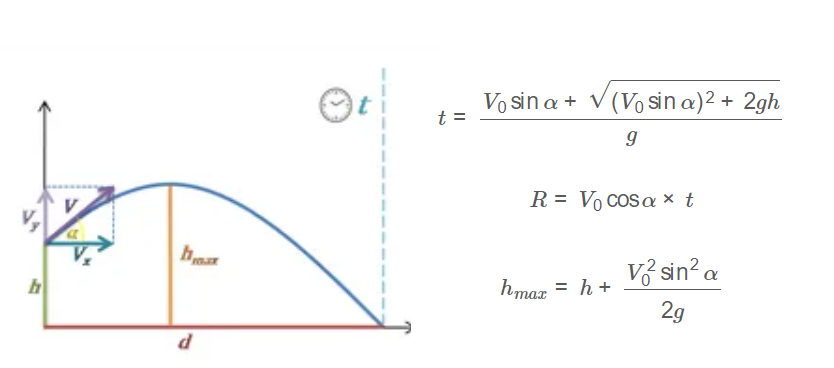1. What is a Projectile Motion Calculator?
Definition: This calculator determines the time of flight, range, and maximum height of a projectile given its initial velocity, launch angle, initial height, and gravitational acceleration.
Purpose: It is used in physics to analyze the motion of objects launched into the air, such as a ball thrown at an angle, aiding in understanding projectile trajectories.
2. How Does the Calculator Work?
The calculator uses the following formulas:
Time of Flight:
\[
t = \frac{V_0 \sin \alpha + \sqrt{(V_0 \sin \alpha)^2 + 2gh}}{g}
\]
Range:
\[
R = V_0 \cos \alpha \times t
\]
Maximum Height:
\[
h_{max} = h + \frac{V_0^2 \sin^2 \alpha}{2g}
\]
Where:
- \( t \): Time of flight (sec, min, hrs)
- \( R \): Range (cm, m, in, ft, yd, km, mi)
- \( h_{max} \): Maximum height (cm, m, in, ft, yd, km, mi)
- \( V_0 \): Initial velocity (m/s, km/h, ft/s, mph, kn, ft/min)
- \( \alpha \): Launch angle (degrees, radians)
- \( h \): Initial height (cm, m, in, ft, yd, km, mi)
- \( g \): Gravitational acceleration (m/s², ft/s²)
Unit Conversions:
- Velocity Units (V₀): m/s, km/h, ft/s, mph, kn, ft/min
- Angle Units (α): degrees, radians
- Height Units (h, R, h_max): cm, m, in, ft, yd, km, mi
- Gravity Units (g): m/s², ft/s²
- Time Units (t): sec, min, hrs
Steps:
- Enter the initial velocity (V₀), selecting the unit
- Enter the launch angle (α), selecting the unit
- Enter the initial height (h), selecting the unit
- Enter the gravitational acceleration (g), selecting the unit (default is 9.81 m/s²)
- Convert all inputs to SI units (m/s, radians, m, m/s²)
- Calculate the time of flight, range, and maximum height
- Select the desired units for the results and view the values
3. Importance of Projectile Motion Calculation
Calculating projectile motion is crucial for:
- Physics Education: Understanding the principles of motion under gravity.
- Sports and Ballistics: Analyzing the trajectory of balls in sports or projectiles in ballistics.
- Engineering and Safety: Predicting the path of objects in scenarios like artillery or safety assessments.
4. Using the Calculator
Examples:
- Example 1 (h = 0): Initial velocity \( V_0 = 20 \, \text{m/s} \), angle \( \alpha = 45^\circ \), initial height \( h = 0 \, \text{m} \), gravity \( g = 9.81 \, \text{m/s}^2 \):
- Angle in radians = \( 45 \times \frac{\pi}{180} = 0.7854 \, \text{rad} \)
- Time of flight = \( \frac{20 \sin(0.7854) + \sqrt{(20 \sin(0.7854))^2 + 2 \times 9.81 \times 0}}{9.81} = \frac{14.142 + \sqrt{200}}{9.81} = \frac{14.142 + 14.142}{9.81} = 2.885 \, \text{s} \)
- Range = \( 20 \cos(0.7854) \times 2.885 = 14.142 \times 2.885 = 40.800 \, \text{m} \)
- Maximum height = \( 0 + \frac{(20 \sin(0.7854))^2}{2 \times 9.81} = \frac{200}{2 \times 9.81} = 10.194 \, \text{m} \)
- Example 2 (h ≠ 0): Initial velocity \( V_0 = 30 \, \text{m/s} \), angle \( \alpha = 30^\circ \), initial height \( h = 10 \, \text{m} \), gravity \( g = 9.81 \, \text{m/s}^2 \):
- Angle in radians = \( 30 \times \frac{\pi}{180} = 0.5236 \, \text{rad} \)
- Time of flight = \( \frac{30 \sin(0.5236) + \sqrt{(30 \sin(0.5236))^2 + 2 \times 9.81 \times 10}}{9.81} = \frac{15 + \sqrt{225 + 196.2}}{9.81} = \frac{15 + 20.528}{9.81} = 3.622 \, \text{s} \)
- Range = \( 30 \cos(0.5236) \times 3.622 = 25.981 \times 3.622 = 94.103 \, \text{m} \)
- Maximum height = \( 10 + \frac{(30 \sin(0.5236))^2}{2 \times 9.81} = 10 + \frac{225}{2 \times 9.81} = 10 + 11.468 = 21.468 \, \text{m} \)
5. Frequently Asked Questions (FAQ)
Q: What is projectile motion?
A: Projectile motion is the motion of an object launched into the air, subject to gravity, following a parabolic trajectory.
Q: Why does initial height affect the range?
A: A non-zero initial height increases the time of flight, allowing the projectile to travel a greater horizontal distance before landing.
Q: What happens if the launch angle is 90°?
A: At 90°, the projectile goes straight up, so the range is 0, and the maximum height is maximized.
Projectile Motion Calculator© - All Rights Reserved 2025
 Home
Home
 Back
Back
